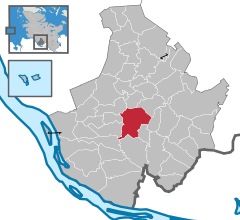Tornesch
| Tornesch | ||
|---|---|---|
| ||
 Tornesch | ||
Location of Tornesch within Pinneberg district 
 | ||
| Coordinates: 53°42′N 9°43′E / 53.700°N 9.717°ECoordinates: 53°42′N 9°43′E / 53.700°N 9.717°E | ||
| Country | Germany | |
| State | Schleswig-Holstein | |
| District | Pinneberg | |
| Government | ||
| • Mayor | Roland Krügel | |
| Area | ||
| • Total | 20.62 km2 (7.96 sq mi) | |
| Elevation | 12 m (39 ft) | |
| Population (2015-12-31)[1] | ||
| • Total | 12,946 | |
| • Density | 630/km2 (1,600/sq mi) | |
| Time zone | CET/CEST (UTC+1/+2) | |
| Postal codes | 25436 | |
| Dialling codes | 04122, 04120 | |
| Vehicle registration | PI | |
| Website | www.tornesch.de | |
Tornesch is a town in the district of Pinneberg, in Schleswig-Holstein, Germany. It is situated approximately 7 km (4 mi) southeast of Elmshorn, and 25 km (16 mi) northwest of Hamburg. Tornesch is also the home of the Klaus-Groth-Schule, named after the German poet Klaus Groth. It is also home to the Fritz-Reuter-Schule, named after German writer Fritz Reuter.
History
Tornesch has a place in biochemical history from the wood saccharification[2] process developed by Scholler,[3] also known at the Scholler-Tornesch process. The first factory to use the process was built in Tornesch. This early work was part of the development of biofuel such as cellulosic ethanol.
References
External links
This article is issued from
Wikipedia.
The text is licensed under Creative Commons - Attribution - Sharealike.
Additional terms may apply for the media files.
